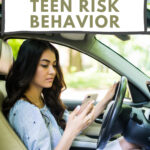Teenage Risk Behavior: How to Support Your Older Child
Teenage risk behavior has always been a challenge, but today’s teens face more pressure than many parents know.
To protect our teens, we must take an unwavering position on a multitude of critical issues. While our jobs as parents certainly become easier once our children are no longer babies, the teen years are a time, once again, when we must pay fierce attention.

One of the reasons that we must pay fierce attention is that our children will take risks during the teenage years. It is normal for them do so. In fact, adolescent risk-taking leads to better decision making in adulthood.
We may believe that our children will be spared the turmoil of adolescence because of our good parenting. And while that is true to a certain extent, we cannot impart our consciousness to our children. Like us, they will have to learn from their own experiences.
Teenage Risk Behavior is Developmentally Normal
We cannot protect them from their first heartbreak. We cannot protect them from contemplating their self-image. We cannot protect them from taking risks – though we will try – but we must protect them from danger.
Rather than trying to talk your teens out of taking risks or punishing them when they do, help them channel their adventurous spirit into healthy risks such as:
- Participation in team sports
- Safe participation in “adrenaline” sports
- Outdoor activities
- Creative pursuits
- Extracurricular activities
- Travel
- Work opportunities, internships, volunteer commitments
Understanding Your Teen’s Brain
The rational part of a teen’s brain isn’t fully developed and won’t be until age 25 or so. In fact, recent research has found that adult and teen brains work differently. Adults think with the prefrontal cortex, the brain’s rational part. This is the part of the brain that responds to situations with good judgment and an awareness of long-term consequences. Teens process information with the emotional part of the brain – the amygdala.
This is why they need extra guidance from you. Talk frankly with them about unhealthy risks and why you are concerned about them. Educate them and share examples of past times when they’ve suffered negative consequences after failing to use impulse control.
How to Support Your Teen
Here are some of the most common risk-taking behaviors during early adulthood and ways you can support your child to make good decisions.
Talk openly about substance abuse
When I was raising my teens, I read the now out of print book, Licit and Illicit Drugs: The Consumers Union Report on Narcotics, Stimulants, Depressants, Inhalants, Hallucinogens and Marijuana to educate myself and found that it presented both sides of many controversial issues.
I made it available to my teens because I wanted them to know that all drugs are not equal. I was afraid that if we only followed the “Just Say No” approach to drug use, they would be unprepared if peer pressure tempted them. So I provided them evidence about the risk factors associated with drug abuse in many different forms.
However, while we usually worry about drugs like cocaine, heroin, or methamphetamines, the fastest growing drug problem in the US today is prescription drugs. Two-thirds of teens get these from family and friends, including from their home’s medicine cabinets.
If you use prescription drugs, recreational drugs, or drink alcohol, make sure that your child or your child’s friends do not have easy access to these things by storing and disposing of them safely and securely.
Regardless, your teens might still be offered illegal prescription drugs. Many fake pills are made to look like prescription opioids such as oxycodone, hydrocodone, and alprazolam or stimulants like amphetamines, but 40% of these illegal pills contain a lethal dose of Fentanyl, a deadly synthetic opioid.
As a result, one teen I know says that she and her friends have adopted the motto, “One Pill Can Kill.” Teach this motto to your teens and educate them about the skyrocketing problem of Fentanyl.
Alcohol use has long been a concern when it comes to high-risk behaviors for high school students. Talk with them about the potential health outcomes of binge drinking like alcohol poisoning. Give them options for how to get home safely (call you, another adult, get an Uber or Lyft) if they’re out with other kids who have been drinking.
Be clear about the dangers of vaping and tobacco use
Ninety percent of adult smokers had their first cigarette before they were 18. So your teens may be tempted by peer pressure to smoke cigarettes. Fortunately, youth cigarette smoking dropped to an all-time low of 2.3% in 2021—down from 23% in 2000. The big temptation today, however, is e-cigarettes and vaping is very popular among teens.
Vaping reached a peak of 18.1% of teens in 2019, but it dropped to 13.3% in 2021. It is linked to acute lung injury, COPD, asthma, lung cancer and heart disease so you must actively educate your teen about vaping. This vaping guide for parents might help.
Set guidelines and help them navigate social media and cell phones
The pressure on young people to get a phone is so intense that it can be hard for parents to say no. But fortunately, some schools are now setting boundaries on their use. The creators of cell phones and social media readily admit in the documentary, The Social Dilemma, that both phones and social media were intentionally designed to be addictive. They wait until their own children are 14 to give them phones.
One study of 5000 people found that higher social media use correlated with self-reported declines in mental and physical health and in life satisfaction. And, according to Nicholas Carr, author of The Shallows: What the Internet if Doing to Our Brains, it is the internet itself that is the problem. The internet colonizes our minds, changes the way that we think, and makes us ever hungry for more.
Too much screen time has been linked to obesity, attention issues, sleep problems, mood problems, poor self-image and low self-esteem, and even violent behavior. Be familiar with what media your teens are consuming. If your teen can’t put their phone down at meals or stays on it late at night, here’s how to address technology addiction.
Talk to them about advertising and how it influences our choices. Encourage other activities that do not involve screens. Teach your teens about online privacy and safety. Be a good role model with your own screen time habits. Claim your authority as a parent by actively deciding when your child is ready for a personal device.
Raise a conscientious, prepared driver
It was when my children first started to drive that I knew for sure there had to be a God. In the state where I lived, teens could get their driver’s licenses at 15 and their permits when they were 14. It was terrifying.
Since then, the state has raised the age for licensure and implemented Graduated Driver Licensing, in which restrictions are put on the number of passengers, and on nighttime and highway driving. If your state does not do have Graduated Driver Licensing, create your own with your teen.
Thirty-seven states ban all cell phone use by novice drivers.
Talk to your teen about the consequences of distracted driving. Explain that a text message can always wait. Talk with your child’s friends about safe driving to help set the foundation of peer influence. Set a good example by your own undistracted driving and give your teens a message that is consistent with what you do yourself.
Set and stick to a curfew
As parents of teenagers, it’s common to think our children don’t need our boundaries as they grow older. But they sometimes need them more than ever. While they may be taller, they are still children. Set a curfew with them that you can both agree on, but don’t be pressured into making it later than you can bear, because a curfew can be a life saver for you both.
It can give your teens a reason to get out of an uncomfortable situation and reassure them that you have their back. I said to my teens, “I will come and pick you up no matter where, no matter what time.” I made it clear to them that I wouldn’t be mad at them if they were late, but that I would be worried sick and at some point, I would call the police.
This proved to be comforting to my 11-year-old son when he got lost in the woods with a group of friends. As they sat around the fire guessing what their parents were doing, one girl said, “My mom is channeling us.” My son, who had heard me talking to his older brother and sister many times, said, “My mom is calling the police.”
Keep an eye out for warning signs
It can feel like walking a tightrope to appreciate our teen’s need to take risks on the one hand and protect them from harm on the other. If you’re worried that your teen may be engaging in dangerous risk-taking behavior, look for these warning signs:
- Ongoing debilitating emotional distress
- Withdrawal or alienation
- Frequent crying or violent outbursts
- Lack of friends
- Drop in school performance or attendance
- Not checking in or abiding by curfew
- Engaging in illegal activities or criminal behavior
- Lying
Offer your teens appropriate coming of age rituals and rites of passage. Make your home a safe refuge. Make it a place where your teens and their friends want to hang out. Repeatedly offer them a chance to try new things from the positive risks listed above. Feed them. Talk to them. Listen to them on a regular basis. Be the example you want your children to follow. And know that you’re doing your very best to help them become the independent young adults they’re meant to be.
Conscious Parenting Resources for Raising Teens
Here are some books and documentaries that deal with teenage risk behavior and how to support your child through:
Emotionally Resilient Tweens and Teens by Kim John Payne and Luis Fernando Llosa
How to Talk So Teens Will Listen and Listen So Teens Will Talk by Adele Faber and Elaine Mazlish
Digital Madness: How Social Media Is Driving Our Mental Health Crisis – and How to Restore Our Sanity by Nicholas Kardaras
The Hero’s Heart: Coming of Age Circle for Boys (and the Mothers who Love Them) by Melia Keeton-Digby
Brainstorm: The Power and Purpose of the Teenage Brain by Daniel Siegel
Reviving Ophelia: Saving the Selves of Adolescent Girls by Mary Piper and Sara Gilliam
Raising Cain: Protecting the Emotional Life of Boys by Dan Kindlon and Michael Thompson
Merchants of Cool, Frontline PBS
Growing Up Online, Frontline PBS

